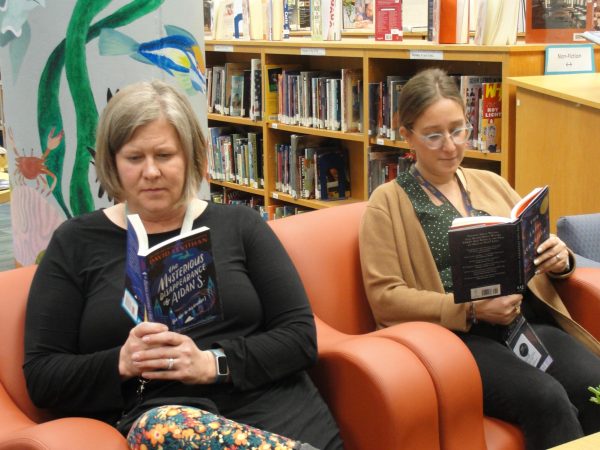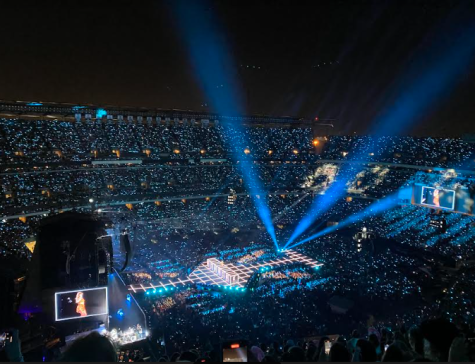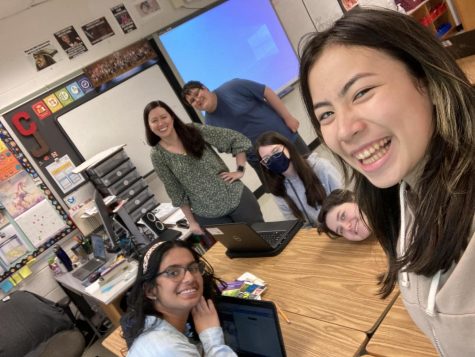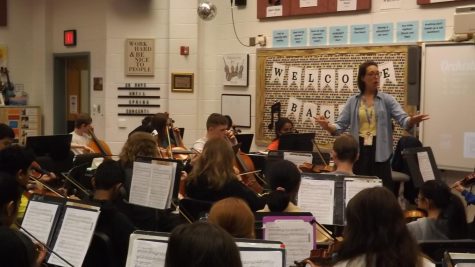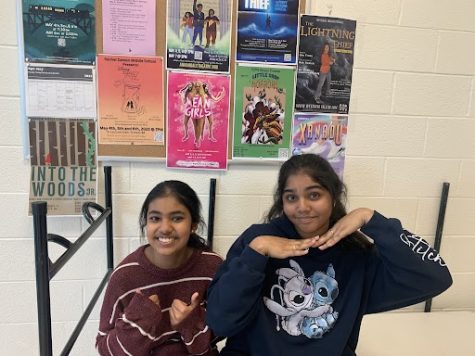An experience through the stories of ‘Encore’
The rush of excited students crowded the entrance as they squeezed through the auditorium’s door, motivated to find the seat of their choice while they awaited a performance that they would never forget.
Carson’s seventh-graders experienced the beloved stories of “Encore,” through a live performance at George Mason’s Performing Arts Center on Nov. 26.
“When I walked inside the auditorium, it gave me an eerie feeling because it was so bright and sunny outside, but when we stepped inside, a dark feeling got us into the right mood,” Aishetha Nagabhirava, 13, of Dream team, said.
There was about 900 students and teachers in the audience. The audience included seventh-graders from Carson and students from another school.
The show started with an excerpt from the notable poem, “The Raven” by Edgar Allan Poe. This poem talks about a talking raven’s mysterious visit to a distraught lover, tracing the man’s slow fall into madness.
“‘The Raven’ was worked out well. It was chilling and secretive at the same time,” Aishetha said.
Right after “The Raven” was over, they went immediately to “The Tell-Tale Heart,” by Edgar Allan Poe. This story is narrated by an unnamed narrator who tries to convince the audience of the narrator’s sanity while describing a murder the narrator committed.
“I remember in ‘The Tell-Tale Heart,’ he starts hearing the sound of the heart of the person he killed,” Aishetha said. “He heard this voice in his head and went crazy.”
After ‘The Tell-tale Heart,’ there was a 10-minute break where the actors changed their costumes and changed the back-drop.
“I knew the stories would be exciting, because Mr. Davis, my English teacher, told our class about some of the stories before the field trip,” 13-year-old Aishetha said. “He especially talked about Edgar Allan Poe. He told us that Poe was a popular writer, and Mr. Davis told us that he wrote a lot in the horror genre. Since I love horror, I knew that the field trip was going to be fun and entertaining.”
Soon after the break, the audience diverted their attention to the stage for the story “The Legend of Sleepy Hollow,” written by Washington Irving. This story relates the misfortunes of the gangling schoolmaster, Ichabod Crane, and his midnight rendezvous with the Headless Horseman.
“In The Legend of Sleepy Hollow, I liked the comedy in it, and the dancing and singing,” Alice Samuel, 13, of Dream Team said. “It was funny whenever the character, Ichabod Crane, attempted to impress Katrina Van Tassel.”
After “The Legend of Sleepy Hollow” followed “The Monkey’s Paw,” written by W.W. Jacobs. In this story, three wishes are granted to the owner of The Monkey’s Paw, but the wishes come with an enormous price for interfering with fate.
“I liked how the lesson in ‘The Monkey’s Paw’ is that if you wish for something that there will always be a consequence,” Alice said. “It’s true.”
The next story was “The Necklace” by Guy De Maupassant. This story shows Mathilde Loisel’s dreams of the more beautiful things in life and is not content with her secure, middle-class home. The price she pays for a single evening of elegance is a lifetime of drudgery and despair.
“I vividly remember the end of ‘The Necklace,” said Mr. Stephen Davis, The Dream Team English teacher. “The students seemed surprised by the twist at the end, and that was great.”
Soon after the “The Necklace” was finished, the final story, “The Celebrated Jumping Frog of Calaveras County” by Mark Twain, was performed. This story shows the brawling, risk-taking, highly competitive society that was frontier America in the 19th century.
“My favorite part of ‘The Celebrated Frog of Calaveras County’ was when the dancer dabbed and did the floss,” Alice said. “That moment brought back previous years’ trends.”
Watching “Encore” showed the audience a new perspective in the world of storytelling that could never be found anywhere else.
“The students should learn an appreciation for this,” Mr. Davis said. “Just because a story is old, does not mean it isn’t good. We should all learn how to respect the theater.”

Ayisha Asharaf is a seventh-grader on Rachel Carson's Dream Team. In her free time, she enjoys playing soccer and badminton.

